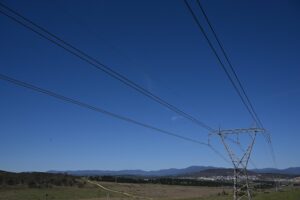It doesn’t matter how much Tony Abbott and his Coalition ape their Republican mentors about the future of energy, in Australia, the die is already cast, and it is most definitely green.
That much was the conclusion of the Australian Energy Market Operator’s annual Electricity Statement of Opportunities, which threw a bucket of cold water over the fossil fuel industry by concluding that there was no need for any new coal or gas fired baseload generation for the next decade at least. The document was long and detailed, but it contained a simple message: there’s nothing to do here, unless you feel like building a wind farm or two, or the estimated three thousand that will be needed to meet the renewable energy target.
This conclusion has been brought about by a dramatic reappraisal of Australia’s energy demand forecasts. Interestingly, this is the first time that AEMO has taken responsibility for the producing the demand forecasts by itself – up until this year it relied on input from the transmission networks in states such as Queensland and NSW, the very state-government owned organisations that would benefit from high demand forecasts because it would help them justify the construction of more poles and wires, the subject of Julia Gillard’s graphic but belated intervention into the electricity price debate this week. OMG! Are you thinking what I’m thinking?
Abbott’s graphic blindness
We’re certainly not too sure what Tony Abbott is thinking. All the evidence, from the government, from Professor Ross Garnaut, from the Australian Energy Regulator, the Australian Energy Market Commission, the Australian Energy Market Operator, the (conservative) state governments, the independent pricing regulators, academics, consultants, researchers, industry leaders, analysts, and anyone (including my neighbour) who has seen the graph below, or any other graph similar, makes it is clear that network costs are imposing the greatest burden on consumers – far more than the carbon price – and much of it might not be necessary.
“No, it’s not,” said Abbott, about a gazillion times this week.
Yes, it is. And if you look really, really, hard, you might see the cost of green energy schemes.
The Cappuccino inflation index
For a quick diversion, here’s another graph provided by the consultancy firm Exigency. The daily cost of electricity is now more than a price of a cappuccino, though I’d like to know where you can get such a cheap one in Sydney, or Melbourne for that matter. And below it highlights how once your daily connection was cheaper than your coffee. Not in the past few years though, and network costs are mostly to blame.
Taken for a ride
Abbott’s heroic defence of an effective one-liner aside, it’s a shame that the government wasn’t a little more attentive to the warnings of Garnaut when he completed his update of his Climate Change Review more than a year ago. If they had read those documents carefully, they would have learned that not only were they being taken for a ride by the networks, but by the generators too – who were threatening that lights would go off if they weren’t given billions of dollars in compensation. “I just don’t see the point of compensation,” he said.
But such is the extent of regulatory capture in the electricity sector, that the government has handed out billions of dollars to coal fired generators to ensure they stay open, offered billions more to ensure that some actually close, as well as offering loan guarantees to all and sundry in case they get into a spot of bother (which is probably all they needed in the first place).
The latest AEMO forecasts point out that no new generation is needed for a decade, and we’ve probably already got too much. There was never any danger of the lights going out. The government’s attempts to buy out up to 2000MW of coal fired generation are being frustrated because the big power stations they targeted were offered so much in compensation that they don’t want to shut down. Even Australia’s biggest investor in green energy, AGL Energy, decided that buying a compensation-enriched brown coal utility, the most polluting in the country, was the best deal it could do for its shareholders.
The industry even mocked Garnaut’s suggestion about the non-baseload future for brown coal generators, where they could be shut down for months and used more sparingly in times of greater demand. The industry said Garnaut didn’t know what he was talking about. Yet that is exactly what the largest coal fired generator in South Australia, the 540MW Northern power station, is doing – shutting down for the winter months, when demand (and prices) are low. It won’t be the last.
Can tattooed voters save solar?
This is the real big threat to the generators and the network providers – the likely proliferation of solar PV on household and commercial rooftops as the price of panels fall and the cost of grid-connected electricity rises. These are based on AEMO’s medium scenario, which is likely to be highly conservative. Private forecasts suggests it could be double. Either way, it represents a tangible threat to the earnings of the incumbents.
RenewEconomy has outlined how the utilities may respond in this article. Consultants Exigency flagged in a recent report that that electricity sector would likely fight back with an increased focus on fixed charges in preference to variable usage charges. This has already happened, but, as Exigency has pointed out, it has major implications for public policy and is likely to be taken up by consumer advocacy groups.
Still, in yet another example of regulatory capture, the government seems convinced that solar is something that only the rich can afford, despite evidence to the contrary and the emergence of cheap financing. (On the flip side, it was welcome to see Climate Change Minister Greg Combet call out the state pricing regulators for allowing utilities to pass on costs for renewable energy certificates that were way above the market price).
But on the pricing issue, and the selling of green energy, former US president Bill Clinton, during a recent visit to BrightSource Energy’s Ivanpah solar project in California, broke down the problem this way when he noted how many of the workers at the site were tattooed. “The more people with visible tattoos who advocate for clean energy, the more success it will have in Washington,” he suggested. “You win the tattooed vote and we’ll have the damnedest environmental policy anybody ever saw.”
We’re not so sure, but perhaps the Australian clean energy industry can take the cue. If you come across a tattooed man, or tattooed woman, offer them a job. If that doesn’t work, sell (or lease) them a solar system.











